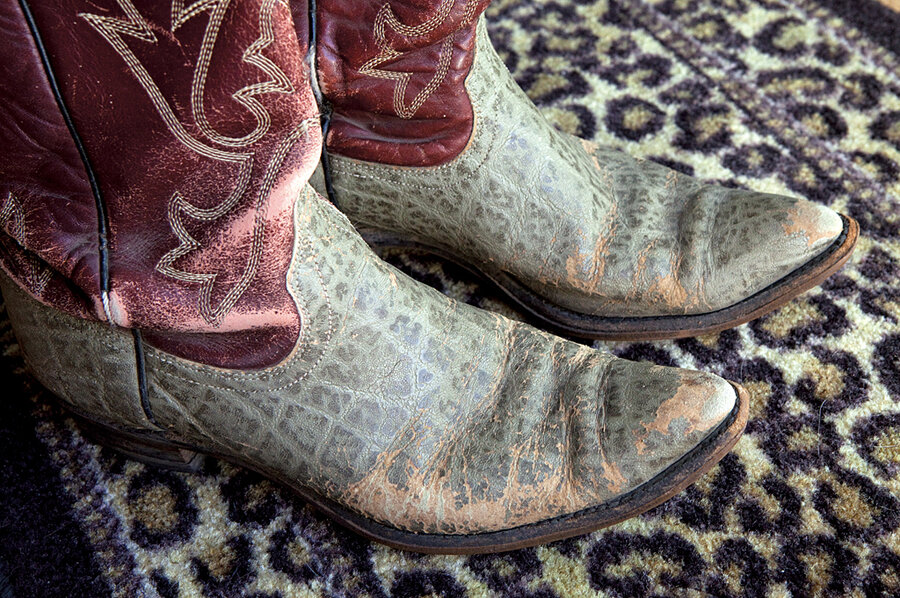I have shoes for any occasion
Loading...
Everyone staying at the Kinshasa hotel in the spring of 1997 was, like me, a reporter covering the crumbling of Mobutu Sese Seko's reign. Everyone except a chatty but mysterious American who greeted waitresses at breakfast with "Bahn joor, baby." His accent was so bad, I was convinced it masked a Parisian fluency deployed during shady diamond dealings, or when he reported back to Mr. Mobutu's henchmen about what the foreign reporters were saying about the dictator of what was then known as Zaire (now Congo).
One afternoon, my colleagues and I stood in the lobby, discussing a protest that had gotten out of hand and ended with several journalists being robbed of even their shoes. The suspected diamond dealer glanced at my still-shod feet and pronounced that my black high-tops would be safe to wear to the next riot, because no one would want to steal Chucks.
Let Proust have his madeleines. I have my shoes.
I can be forgiven for trying to make my shoe habit seem intellectual, or at least cool. I take plenty of teasing about it at home. My 9-year-old daughter hides shoe catalogs from me. She feigns fear I'll spend her inheritance at the shoe shop. Hoping to shame me into restraint, she'll tell anyone who will listen: "Mommy has a lot of shoes." Most listeners probably think that means a closet full of Christian Louboutin heels. They'd be disappointed. I own nary a red sole. My tastes tend more to those high-tops, and not just in riot-ready basic black.
I sometimes need to be fast on my feet; I always need to be color coordinated.
You need only peek in my mom's closet to see that I come honestly by my shoe mania. She has a lifetime collection stacked in towers of the original boxes. Her tastes run to classic pumps and high heels. But when a young co-worker once came to her, in near tears because her own mother was insisting she buy a pair of heels – her first – for her wedding, my mom counseled her to stick with her favorite tennis shoes, perhaps with lacy ties for the occasion.
After Converse, the most represented brand in my shoe closet is Goodyear. I have several sandals fashioned from old tires, and every time I stretch on a pair I'm reminded of the inventiveness of recyclers in the developing world.
African cobblers find novel ways to loop and weave laces, creating a pattern across the foot. They incise the rubber to generate more interest by revealing black-and-white designs. A Pakistani cobbler caught my interest with a simpler method: pile the color atop soles made from tires. The straps on my Pakistani pair are dyed red and embroidered with curlicues and florets in at least as many colors as I have high-tops. I brought them back from a temporary assignment in Islamabad and proudly showed them to my landlady's daughter in New Delhi, where I was based at the time.
"Very Baluch," she said, referring to Baluchistan in southwest Pakistan. I thought, "Well, that's the point," recognizing that she hadn't meant it as a compliment. It wasn't a political statement rooted in decades of Indo-Pak tension. She just didn't like my shoes. I didn't mind. I've happily worn my wild Baluch sandals for years.
Not all my shoe tales are exotic. Or mine. Or even, perhaps, true.
My husband took me to Santa Fe, N.M., to celebrate our wedding anniversary. Naturally, we ended up at Kowboyz, with its huge selection of used cowboy boots. My husband planted himself near the cash register, chatting with the owner, while I combed shelves full of prizes in my size in the women's department. We must have been in there three hours.
I got a wonderful black-and-white women's pair. The real find for me, though, was in the men's department. A rich oxblood color, they are by Lucchese, the Louboutin of cowboy boots. The dandy who wore 'em and left 'em had tiny feet for a man. He had barely scuffed the soles. Had he spent gambling winnings on them, then sold them the next month to pay the rent? Perhaps he was a dot-com millionaire who bought them on a whim, only to find they pinched. I like to think he was a down-on-his-luck rodeo cowboy, tough and wiry, with fine boots his one indulgence. I hope he got together enough cash for an even finer pair. I wish I could thank him for breaking in mine.
Three hours is a long time to just sit surrounded by boots with stories to tell. My husband did break down and try on a pair with fabulous toes: ostrich skin dyed turquoise. He decided they pinched, and left them on the shelf. If only my particular dandy had had daintier feet.
And my daughter? I've seen her eying my Kowboyz purchases. I got her a pair of red boots at Christmas, and her face lit up when she opened the box. I think she's hooked.





